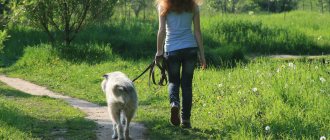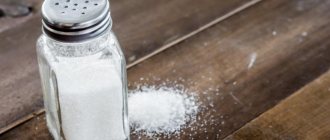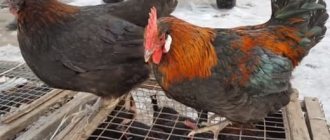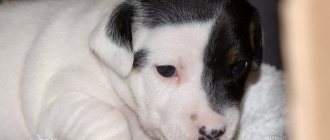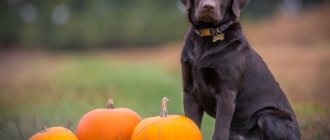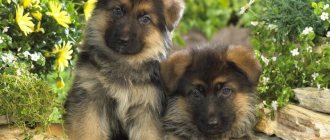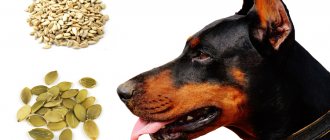May be associated with certain diseases of internal organs, such as the liver or pancreas. First of all, of course, contact your veterinarian. He will order tests for you (clinical and biochemical blood tests and stool tests). If they detect diseases of the internal organs, the veterinarian will prescribe your dog a course of medication and select a suitable diet for it.
Perhaps the dog is due to helminth damage to the body. This can also be determined by a veterinarian by looking at the test results. If such a problem exists, buy an anthelmintic drug (your veterinarian will also help you choose the right one) and give it to your dog. Usually, after solving this problem, the dog regains its appetite, and it quickly gains the weight it needs.
If everything is fine with your dog, then you should reconsider its diet. If you feed your pet natural food, do not forget that a dog is, first of all, a dog! When feeding natural food, take food rich in animal proteins as the basis for your dog’s diet - meat, fish and dairy products.
When preparing porridge for your dog, keep in mind that there should be about 70% meat or offal, and 30% cereal. First cook the cereal (rice, buckwheat, preferably millet - this is the richest cereal in fat. But please note that millet must be thoroughly boiled) and only then add finely chopped meat, offal or fish to the porridge. Meats that can be given to dogs include beef and chicken. The beef is either steamed or well frozen. Be sure to remove all long bones from the chicken before feeding it. Give ocean fish, after lightly boiling it and removing all the bones.
Feed the offal (heart, lung, liver, kidneys, tripe) raw to the dog, except for the liver - it should be boiled. Feeding raw, unpeeled beef tripe helps your dog gain weight. Give it to your dog before bed in its pure form, that is, without porridge, as an additional bait. Several times a week, give your dog fermented milk products between feedings: kefir, Varenets, cottage cheese.
Imperfect weight is a problem not only for owners, but also for their four-legged pets. Most often we are talking about excess body weight. However, there are times when, on the contrary, a worried owner is racking his brains over how to get a little one to eat an extra piece and build up some fat on the ribs.
Before starting a program to increase your pet’s body weight, ask yourself again how much such changes in the figure are necessary for him. The point from which the report must begin can be the breed standard. It clearly indicates not only the recommended weight and height at the withers, but also the condition - you will agree that a greyhound will be a variant of the norm, for an English bulldog - the initial stage of dystrophy.
The second thing to consider is the animal’s physical activity. It is clear that an active dog will spend much more calories than a lazy dog lounging on pillows. And muscles, for the most part, look much less voluminous than fat.
The third important aspect is the well-being of your four-legged friend. Pay attention to how the dog feels. Symptoms such as vomiting, diarrhea followed by constipation and deterioration in well-being after a specific product should definitely alert you. Depending on this, a further strategy for combating thinness is chosen.
Diet
There are several ways to combat low weight pets. The first thing that changes should affect is the dog’s daily menu. The simplest and most obvious way to solve the problem is to increase your pet's daily diet. The easiest way to do this is if the dog is eating. You simply increase the drying volume by 10-15% and monitor the dog for several weeks.
If you think that stuffing your belly full of food is a bad idea, just change the dryer. In the line of any manufacturer you will find food with a high content of proteins and fats. Just remember to make the transition smooth so as not to upset your pet’s gastrointestinal tract.
For those who eat natural foods, increasing the nutritional value of their diet is even easier:
- Firstly, remove completely unnecessary ballast from the animal’s diet - which only increase the volume of the stomach and are poorly absorbed by carnivores.
- Secondly, introduce high-calorie sea fish, meat and offal into your diet. For your own peace of mind, you can scald the product with boiling water or, if you are confident in its quality, serve it raw.
- Thirdly, introduce a sufficient amount of greens and vegetables into your diet. Of course, silage itself, as it is called, is unlikely to be able to round out the sides of your slender friend, but in combination with meat it significantly improves the digestibility of the latter.
- When feeding an animal with meat, be aware that this product is often of different quality. And the point here is not even in the degree of freshness, but in the nutritional value of this or that piece. The more veins, skin and chaff the meat contains, the more product the dog should eat to be satisfied. No one encourages you to feed your pet pure tenderloin, but it won’t hurt to increase the daily intake by 15-20% if the diet consists of flank meat or offal.
- Drastically increasing the volume of food is another common mistake that well-intentioned owners make. Don’t think that if you give your pet three daily doses of food today, he will instantly become smooth and beautiful. The only thing you will achieve is problems with the gastrointestinal tract and vomiting of undigested remnants of goodies.
Feeding pregnant and lactating bitches
Pupping in Labrador bitches lasts about 2 months.
For the first half of the pregnancy, feed the pregnant dog unchanged (excess weight will complicate childbirth).
In the second , they increase the amount of meat (up to 1.5 kilograms per day or
by 10-15% per week), vitamins and microelements (strictly observing the proportions) or simply switch to food for puppy bitches, the composition of which already takes into account the physiological state and needs of the animal for building material.
If the dog gets what it needs, then whelping and subsequent lactation will have little or no effect on its condition, coat quality and overall health.
If you switch the bitch to puppy food, there is no need to increase the portions or add vitamins and microelements. Feed your dog 6-8 hours after giving birth unless he asks sooner. With milk, a dog gives away 4-7% of its body weight every day. To ensure that the puppies grow up healthy and do not “drink” it, feed the bitch more often than usual (3-5 times) - the same as in the second half of pregnancy.
Remember about fresh water: it is needed for milk production. If the dog's diet is natural, its food should be liquid (thin porridge, meat soup, milk). Do not give potatoes: starch can clog the milk ducts.
A month to a month and a half after giving birth, gradually reduce the number of times the bitch feeds and the amount of water she drinks in order to smoothly complete the lactation period.
Medical examinations
The reason for your four-legged friend's thinness or lack of appetite may lie in poor health. These can be either problems with the digestive system or various pathologies of internal organs. How should the owner behave in this case?
If the dog’s diet and health are not satisfactory, but the four-legged little one still refuses to eat, just try to outsmart him. Here are some ways you can stimulate your pet's appetite:
- Set a 15 minute rule. This is exactly how long it takes a dog to taste and eat everything in its bowl. If after a quarter of an hour the food remains untouched, simply put it in the refrigerator until the next feeding. Attention: do not offer your pet food that has been in the bowl more than 2 times. In the hot season, even such a short time is enough for pathogenic bacteria to appear in food.
- Increase your physical activity. Remember ancient folk wisdom? “He who works well eats well.” Provide the animal 2-3 times a day, and its appetite will change for the better. Attention: you can run and jump only before eating, lightly. Active games are strictly contraindicated with a full stomach.
- Arrange fasting days. Don’t be afraid that forced hunger strikes will make your slender four-legged friend even slimmer. A fasting day a couple of times a month will awaken in the dog the ancient instinct of fear of hunger. Knowing that there is a time when there is no food at all, the animal will be more enthusiastic about accumulating calories. Attention: Short-term hunger strikes should be carried out only after a thorough examination of the dog in the clinic. Such unloading is contraindicated for animals whose thinness is caused by gastrointestinal diseases.
- If your shaggy capricious one turns up his nose at any food, use a trick. Add a little grated boiled liver or a couple of tablespoons of canned baby meat to your main diet. This addition will give the dish a more appetizing smell and taste. Attention: Do not use fatty foods with a lot of flavoring additives as seasoning. Smoked sausages will certainly whet the animal's appetite, but the negative effect they have on the liver will significantly shorten the dog's life.
The owner's greatest desire is for his dog to be healthy and cheerful. If, despite all the tricks, your pet maintains a lean appearance, while remaining active and cheerful, allow him to eat as much as he wants. After all, wise nature knows better what thickness your dog’s waist should be.
Sometimes a dog loses a lot of weight after a long illness or due to other reasons. What to feed your dog to make it gain weight - this issue needs to be dealt with in a timely manner. Remember that you need to fatten the animal in such a way as not to disrupt the metabolism in the body.
Before you decide how to properly feed a thin dog so that it gets fat, you need to figure out whether the weight really cannot be called sufficient for its physique and age. Both his health and his predisposition to illnesses in later life depend on whether the pet’s weight is normal. At a normal weight, the dog develops fully, and intense physical activity does not burden it.
Mr. Tail recommends: rules and regulations for feeding dry food (by breed, age, weight)
As a rule, daily consumption rates are indicated by the dry food manufacturer on the packaging. But this information is for informational purposes only, since manufacturers do not know the individual characteristics of the pet.
Small breed dogs are often intensely active and have a faster metabolism, while their medium and large dogs move more slowly and their metabolic processes are often less active. Small height and body weight force the dog to stay in the lower layers of the atmospheric air, therefore, in the winter season, it can freeze more and burn the resulting calories faster.
Old dogs need a softer food structure, while young dogs need bones and hard food. Veterinarians have concluded that the best daily diet for a dog's health is a dry to wet food ratio of 75% to 25%.
Manufacturers have divided food into classes, each of which is characterized by its calorie content per 100 grams of product.
The higher the calorie content, the less food the pet needs, since the body is saturated faster, thanks to the proteins contained in it in kcal:
- holistic – 350-450;
- super premium – 350-450;
- premium – 300–350;
- economy – 250-300.
Holistic food is made from the highest quality products and can be recommended for specialized feeding as hypoallergenic. Super-premium granules are complete nutrition, premium - contain by-products and animal proteins, economy - low-quality products, you need to additionally include vitamin supplements in your diet.
For one-month-old puppies, it is preferable to prepare soaked dry food granules so that tooth enamel does not wear off.
For small breeds from 2 to 5 kg, it is recommended to give 50-100 g of dry food per serving for an active lifestyle, and 30-80 for an inactive lifestyle.
For dogs whose weight starts from 10 kg, with good walking and play, 150-170 g are required, for their less active relatives - 120-150. Further, the rate of one dose increases by 100 g for every 10 kg. That is, if an animal weighs 20 kg - 250-270, 30 kg - 350-370 g, etc.
If the food is chosen correctly, the dog looks cheerful, shows interest in games, and has a healthy, shiny coat. If the diet is incorrectly selected, the dog may begin to gain extra pounds. To prevent this from happening, you need to control whether she manages to eat a portion in 20 minutes or not.
If it doesn’t eat, then it is reduced. They don’t force you to eat up uneaten leftovers. They are thrown out.
If the basis of nutrition is dry granules, then the pet needs more water than with wet feeding. Therefore, it is important to always have fresh water in your drinking bowl.
It is known that Labrador retrievers never refuse food, they eat everything very quickly and to the last crumb, they tend to pick up everything edible that they come across on the street and beg for food from the owner even after eating according to the schedule.
Therefore, representatives of this breed have a tendency to become obese. To avoid weight problems, it is important to control the amount of food consumed and create a clear, repeatable feeding schedule every day.
It is important not to allow your pet to lead a sedentary lifestyle; you should motivate him to spend time actively and engage him in games, which will avoid weight gain. Weight control should be carried out regularly, your pet should not be overly pampered with treats, and food should not be used frequently as a reward.
To prolong food intake, it is recommended to use maze feeders or cut the meat into larger pieces so that the pet is forced to chew them. It is better to choose a place for feeding that is calm, hidden from strangers, so that the dog feels comfortable and does not try to quickly swallow the food, worrying that it may be taken away.
Causes of weight loss
Sometimes the owner of a four-legged creature notices that his pet suddenly began to rapidly lose weight and eat poorly. The best way out of the situation is to take the dog to the veterinarian and undergo a comprehensive comprehensive examination. However, keep in mind the fact that this will cost you a decent amount. That’s why you should first establish the reason for your dog’s rapid weight loss, and only then make a decision.
Common factors that cause weight loss in a pet include the following:
- Feeding your pet's offspring. After this, the dog usually requires serious recovery.
- Dogs living in the same house cannot share food among themselves. In this case, it is advisable to isolate the malnourished dog from other individuals during feeding.
- The dog suffered from a helminth infestation. In this case, you need to give the animal special anti-worm medications, otherwise the consequences may be tragic.
- This is due to the young age and individual characteristics of the breed.
Feeding offspring
Lack of appetite is not always associated with health problems in your pet. Sometimes she does not feed very actively and at the same time loses weight due to the fact that most of the nutritional components are lost along with the milk. When a dog fattens its offspring, it often loses weight. In this case, it is recommended to increase the portions.
Also make sure that your daily menu includes vitamins.
Then the puppies will receive more useful substances along with their mother’s milk, and the tailed mother herself will not actively lose weight. We should not forget that sometimes the birth of babies in dogs is associated with serious complications. The reason for this is surgery or illness.
High competition for food
Sometimes the owner of four-legged creatures does not notice the exhaustion of one of the pets in a timely manner. It would seem that the food is distributed evenly, and each of your doggies has their own bowl for food. However, keep an eye on your animals while feeding: it is quite possible that someone is left without treats because they cannot win their “place in the sun.” All you have to do is feed the deprived dog in another room so that his food is not taken away.
Age and characteristics of the breed
Among the reasons for a dog's sudden weight loss, it is also worth highlighting its age and individual characteristics. For example, representatives of working dog breeds often gain weight by the age of 2-3 years. This is explained by the fact that the animal’s metabolism is too active at an early age. Therefore, it is not worth increasing the daily diet.
Keep an eye on your dog first: if he continues to lose weight, you should show him to a specialist and check if everything is in order with his health. After consultation with your veterinarian, you can modify your daily diet.
How many times should you feed your Labrador Retriever?
Up to 3 months, the daily portion for a puppy is 300 g. The daily portion is divided into 4 meals. There should be at least 3 hours between feedings so that the baby has time to digest the food. The last meal should be 2-3 hours before bedtime so that the pet has time to go to the toilet.
After 3 months, the volume of the daily portion is increased to 400 g, but the Labrador Retriever puppy is still fed three times a day, dividing the daily portion into 3 parts of 130 g each.
From 6 months, the number of feedings is reduced to two times: in the morning and in the evening. The daily portion is increased to 500 g and divided into two meals of 250 g each.
Starting from one year of age, the serving size is not increased or increased slightly (by 70-100 g), depending on the activity of the pet. Gradually, the pet is transferred to the diet of an adult dog. You can continue to feed twice a day, or just once a day if your Labrador is not very active.
A dog's diet depends not only on the age and size of the animal, but also on the breed. Labrador Retrievers have their own characteristics, so they need a specific diet. Owners should choose food for their Labrador in accordance with the recommendations of the veterinarian.
How to fatten your pet
In order for your dog to look healthy, have a normal weight and stop shedding, it is necessary to provide it with a balanced diet. You can fatten her up using a set of the following products:
- high energy feeds. These include foods high in protein and protein;
- natural ingredients. Buckwheat, rice, oatmeal - such porridges contribute to weight gain. As for meat, it is better to give preference to beef, rabbit, chicken;
- unrefined vegetable oil - just add a few drops to the food;
- fish, liver, cottage cheese - these products are high in calories and can well diversify a dog’s daily diet.
It is not advisable to mix ready-made food with homemade products, since this will only disrupt the metabolism in your pet’s body.
What food to give to a Labrador with health problems
Obesity
Correct your Labrador's excess weight: reduce the portions by half or switch to food for low-active dogs, which is low in protein and fat, but high in levocarnitine and fiber.
Infectious and oncological pathologies, severe fever
Accompanied by exhaustion of the dog - cachexia. Such animals need a high-energy diet containing a lot of proteins and fats, glutamine, arginine, trace elements, vitamins and fatty acids, but few carbohydrates.
Joint dysplasia
A sick Labrador should receive low-calorie food, with less fat, phosphorus and calcium, and more levocarnitine: weight gain slows down, the load on the bones decreases.
What not to do
Some dog owners prefer to feed their four-legged friend semolina porridge prepared with milk. Refuse this dish, since the dog tolerates the processed wheat product, like cereals in general, with great difficulty. You should not feed your dog lamb and pork, as such meat is too fatty for him.
Do not replace meat with offal - they are given to the animal rarely, as a good meat supplement, but not as the main ingredient. The best option is porridge and soups with meat and vegetables. It is possible to prevent anorexia in your dog and increase his appetite if you follow the basic recommendations of your veterinarian.
Dogs usually have an excellent appetite. Many of them eat as much food as is available to them and gain weight well. Often, domestic dogs weigh even more than is allowed by the breed standard or the characteristics of their constitution. But in some cases, pets need increased nutrition, so any dog owner needs to know how to fatten a dog if necessary.
How much and how often to feed
Labrador retrievers need to be fed 2 times a day: morning and evening. When choosing a pet's diet, you need to find out how much a Labrador eats per day. The amount of feed should always be the same. It depends on age, gender, degree of physical activity, climate, characteristics of the dog and even the time of year.
In the harsh northern climate, as well as in cold weather, the dog should eat 15-20% more food than usual. During hot weather, animals are often thirsty, but their appetite decreases, so the amount of food must be reduced and the amount of water, on the contrary, increased.
Important! When choosing a diet for an elderly pet, you need to reduce the amount of carbohydrates by 20%.
The diet of sterilized dogs should be low in calories. Animals that are being prepared for mating require a lot of food. Males eat 10–15% more than females.
Puppies, pregnant, lactating and older dogs especially need a healthy diet
When to fatten a dog
Malnourished dogs need a special diet. Exhaustion can occur after a bitch feeds too large a litter - over 10 puppies, after suffering a serious illness or surgery.
Exhaustion occurs in dogs that work a lot and do not receive the necessary caloric nutrition. This is especially true for sled dogs that travel long distances and carry loads. Sometimes it is necessary for a dog to gain weight before a show. Fashion includes not only certain breeds, but also some individual characteristics of dogs within the breed: color, height, weight, external fatness. Therefore, dogs are forced to lose and gain body weight due to body fat and muscle mass.
Old animals are often capricious and refuse to eat due to poor health. They quickly develop exhaustion due to disruption of metabolic processes in the body. Before changing their diet, they should be taken to a veterinarian to determine the cause of this condition.
How to formulate a diet for fattening?
The easiest way to fatten a dog on natural food. It has a distinct smell and taste that dogs like so much. Industrial food is not as attractive and does not have a variety of taste. Some animals get bored and bored with them. If the animal receives industrial food, then it can be made more interesting for the dog. For example, mix dry granules with finely grated cheese, boiled and chopped meat, fish, eggs; many animals willingly eat industrial food, to which a little cottage cheese, kefir, and low-fat sour cream are added.
It is very important for puppies and pregnant/lactating bitches to receive dairy and fermented milk products: kefir, fermented baked milk, cottage cheese, cheese, natural yogurt. This improves the digestive system, improves stool, populates the intestines with beneficial microorganisms, and also supplies the body with calcium in an easily digestible form. Feeding dairy and meat products should be spaced out over time, since their combination has a bad effect on the dog’s well-being. Once or twice a week you should include boiled fish with the bones removed in your diet. Porridges are made well with fish broth diluted with water. Only low-fat fish should be given.
Bird eggs are an excellent source of healthy cholesterol and vitamins. They are given boiled. If some dogs like to drink raw eggs. The dog should not be allowed to do this while it is sick, has not gained the required weight, or the bird that laid the egg is showing signs of ill health.
Plant foods - cereals, vegetables, fruits - are a source of essential carbohydrates and a stimulator of the gastrointestinal tract.
An emaciated animal needs to be fed more often than usual: three to eight times a day. If it completely refuses food, you need to drink it with warm water from a syringe and inject glucose medications. Which products should be included in the diet for fattening depends on the individual situation and health status of the animal.
Nutrition for malnourished dogs
Here's how to fatten up your dog after it's exhausted. First of all, she needs to be given meat. Meat for dogs is a source of essential amino acids that these animals cannot get from plant foods and even fish. If an animal has been starving for a long time, then it should be given only heat-treated meat, since it is better digestible, and low-fat, since excess fat upsets digestion, which leads to even greater problems. The daily portion should contain 75-80 percent meat.
The remaining volume should be occupied by products of plant origin. For example, meat goes well with cereals. Buckwheat, rice and oatmeal are good for dogs. Allergy sometimes occurs to corn grits. Wheat cereals are not recommended for feeding predators. Cereals are cooked in water without adding salt. In the resulting porridge add chopped meat and grated raw or stewed vegetables and fruits in their own juice: carrots, beets, apples, spinach.
Fattening puppies after an illness, for example, enteritis, involves including semi-liquid pureed foods in the diet: boiled meat, fermented milk products, liquid oatmeal, thick vegetable soup with pieces of meat. Fattening the bitch after weaning the puppies involves increased nutrition according to the scheme prescribed for her feeding during whelping and lactation.
Feeding for fattening for other reasons
To fatten a dog quickly before a show, it is enough to reduce its physical activity and increase the daily portion of food. There is no need to change your diet. Firstly, if a dog participates in a show, then it is in good shape and gets everything it needs from its menu. Secondly, changing or introducing new products can cause adverse consequences in the form of an allergic rash, dulling and matting of the coat, hair loss, delamination of nails, runny eyes or nose, redness of the eyes and ears. All this will significantly reduce the dog’s chances at the show.
What not to do
Old textbooks on dog breeding advise puppies and adolescents to feed semolina porridge cooked in milk or meat broth. You shouldn't do this. Dogs do not digest wheat well (and semolina is a product of wheat processing), and many dog breeds are allergic to this grain.
You should also not include lamb and pork in your animal diet due to their high fat content. This has a harmful effect on the liver and pancreas and creates a significant additional load on the gallbladder. In addition, pork is a highly allergenic product. The ideal option is rabbit, turkey, veal, horse meat. They are boiled, and for animals in good health they are scalded, chopped and fed with herbal supplements.
You should not replace meat with offal during the fattening period. By-products are less nutritious and are also less digestible. The exception is the liver. It can replace a third of all meat in the daily diet a couple of times a week. You can only feed boiled liver.
To fatten a dog so that it gains weight, you need to increase the calorie intake. Carbohydrate foods provide clean calories, so your dog needs to cook porridge and soups with vegetables and cereals in broth diluted with water.
Fattening supplements
The diet will be significantly enriched with meat and bone meal, fish meal, fish oil, seaweed, St. John's wort, eleutherococcus leaves, nettle, plantain, and dandelion leaves.
Nutrition based on the pet's age
Dogs' nutritional needs vary depending on their age.
Newly born puppies receive all the necessary nutrients from their mother's milk. A weaned pet should be on a balanced diet to ensure healthy growth and development. Because puppies grow quickly, they need more food than adult pets.
Puppy
The main component of nutrition in this case is the building material – protein. You should also not allow an excess of beneficial microelements, since such excesses can be deposited in organs and tissues, which will negatively affect the development and health of the puppy.
During the period of active growth of the Labrador, you need to continue to feed it intensively. As the puppy approaches the status of an adult dog, you can gradually accustom him to regular (adult) food.
Further feeding of the Labrador depends on the degree of activity of the dog and its state of health. Working dogs (for example, shepherds, police dogs, etc.), as well as pregnant and lactating bitches, have a higher energy requirement than other pets. Therefore, their diet needs to be increased.
Dogs in adulthood also require a special approach when it comes to feeding.
As pets age, they become more passive and their energy expenditure decreases. There is a need to pay special attention to the weight of the pet. Excess body weight puts a lot of stress on the internal organs (heart and lungs), as well as on the dog’s musculoskeletal system. Dysfunction of these organs leads to various diseases that significantly reduce the life expectancy of a Labrador. If obesity does occur, he needs a low-calorie diet.
Due to age-related changes, the functioning of the gastrointestinal tract worsens in some “elderly” pets. As a result, you may have problems digesting food, which will most likely also lead to excess weight gain. In this case, the Labrador should be fed often, but in small portions.
What do you prefer to feed your pets?
- Porridge with various additives 45%, 9273 votes
Not only people go on diets, sometimes dogs also need an individual diet. And this is not always associated with excess weight, as is commonly thought; the pet may not gain the required weight. Oddly enough, gaining weight is more difficult than losing it. Especially if your pet for some reason refuses to eat the dry food prescribed by the doctor, and instead has a strange passion for cat food. Therefore, the question of how to help her gain the required weight and why the pet stopped eating with appetite is relevant for many owners!
[Hide]
Standards for natural nutrition
With natural nutrition, take 40 grams of dry food, the same amount of wet food and fiber per 1 kg of body weight. For pregnant women, service dogs and stud dogs, the amount of natural food can be increased.
With average physical activity, a dog weighing up to 40 kg requires per day in grams:
- meat – 600;
- cereals – 500;
- vegetables – 200-300.
During heavy physical activity, a relative in the same weight category needs (in grams):
- fresh meat – 1000;
- cereals – up to 700;
- vegetables – 300.
For increased physical activity, for a dog weighing more than 40 kg, the following should be used per day (in grams):
- meat – 500;
- cereals – 700;
- vegetables – 400.
How should you feed your pet to make it gain weight?
The problem of not gaining the required weight is very often associated with health problems. If your dog was quite well-fed, but suddenly began to lose weight and stopped eating with appetite, this is a very alarming bell. Increasing the dose of food for him is not a solution to the problem. In general, selecting an individual diet is a complex and painstaking process. If you do this thoughtlessly, you can disrupt the animal’s metabolism and get problems for the rest of its life.
Therefore, before fattening your dog, examine it; the most common causes of sudden weight loss are:
Some dog breeds always look thinner, in particular hounds and pointers. As well as young animals, weight gain is more intense after 2-3 years of age. Therefore, there is no need for unnecessary panic. But if you can examine the dog's ribs with the naked eye, and its spine and cheekbones protrude strongly, it is most likely underweight.
The following products help you gain the required weight:
- Specialized high-energy food. Pay attention to the energy content of the food your dog eats and choose the most nutritious options that are higher in protein and protein.
- If you feed natural food, then give preference to cereals such as buckwheat, rice, and oatmeal. The diet should contain complex carbohydrates; they take longer to break down and carry a greater energy charge. For meat, it is advisable to eat whole beef, chicken, and rabbit. High-quality meat contributes to the rapid gain of muscle mass. Do not feed too fatty foods; weight gain should occur due to an increase in muscle mass, and not due to the accumulation of fat masses.
- Mix unrefined vegetable oil into your food, about 1 tablespoon per serving. You can give chicken eggs and a few drops of fish oil 2-3 times a week.
- For variety and for proper weight gain, it wouldn’t hurt to eat fish, liver, cottage cheese, 2-3 times a week.
Three levels of dog fatness
Do not try to feed the animal with food and natural food at the same time. This scheme does not lead to weight gain, but threatens metabolic disorders. Another tip for owners who want their pet to gain weight: feed food three times a day instead of two. In this case, the dose of food may be the same or greater, insignificantly. In addition, when your pet is on an intensive diet, do not forget to monitor his weight and calculate the nutritional value of his meals.
Keep in mind that pets of different breeds should receive a certain amount of calories per day:
- Miniature breed dogs need approximately 110 kcal per 1 kg of weight;
- small dogs have 85 kcal per unit of weight;
- medium breeds for the same weight need 70 Kcal, and large breeds – 65 Kcal;
- For very large or giant breeds, 1 kg of mass requires 65 Kcal.
Food standards for puppies
In order to correctly calculate the daily food intake for a puppy, you need to know its weight and the calorie content of the food itself.
The feed rate is indicated per 1 kg of weight.
| Age | Number of calories (kcal) |
| up to 1 month | 220 |
| up to 3 months | 270 |
| up to 6 months | 150 |
| up to 12 months | 120 |
If it is possible to buy elite food for them, then the dosage is made at the rate of 60 g per 2 kg of weight, not taking into account the calorie content of the food.
For small puppies, food is soaked so that they do not damage their baby teeth.
Gradually, dry food begins to be mixed with canned food, and then they are transferred to adult food.
What to do if your dog refuses dry food?
The now popular dry food is an ideal option for her owner as well. feed takes a minimum of time. At the same time, a high-quality option is completely balanced and allows you to lose or gain weight as needed. Dogs often eat dry food with pleasure, but there are exceptions.
A dog may refuse dry food for the following reasons:
- She is used to natural food and dry food is new to her. If you want to switch your animal to a dry diet, do it gradually. Start replacing a small portion of your diet with dry food, gradually increasing it until it reaches 100%. This will take at least 1-2 weeks; a faster transition is fraught with food stress.
- The food is not suitable for the dog. There are a lot of manufacturers of dry diets and some option may simply not be suitable for your pet. Offer your dog several different foods and settle on the one that the animal will eat with great pleasure.
- Individual non-perception of feed components. This situation is quite unlikely; most foods are universal and hypoallergenic. Moreover, paradoxically, a dog can eat cheap food with greater appetite than more expensive food. This is due to the fact that economy food manufacturers use flavorings to make their product more attractive. While holistic or super-premium food uses only natural ingredients. And they don’t emphasize their taste with additional additives.
Dry food is often prescribed by veterinarians for medicinal purposes, and if your pet refuses to eat it, try this:
Soak dry food in water, low-fat kefir or yogurt. Perhaps your pet will like this option more.
Sometimes pets refuse food due to health problems. Consult your veterinarian to see if your pet may have dental or oral problems or indigestion. A video from the channel “Me and My Tail” will help you learn more about different foods.
Features of the Labrador breed
Labradors are quite large, tightly built dogs, with short, thick hair and a good undercoat. They love to run, swim and have a fairly active lifestyle. Their love for life also includes a passion for food.
The constant desire to chew something plus a lack of physical exercise in the form of active games and long walks will definitely affect the appearance and well-being. These pets are prone to obesity and related problems - heart disease, musculoskeletal problems, diabetes, liver failure. Many Labradors are prone to allergic reactions to food components, which is worth considering when choosing food.
Such characteristics of the breed are taken into account when creating a menu and establishing a nutritional regime that is individual for each period of the puppy’s growth.
Is it acceptable to feed a dog cat food?
Pet food manufacturers differentiate between cat foods for a reason. These pets have different needs and all this is taken into account in the qualitative and quantitative composition of their food. Therefore, it is wrong to feed a dog with cat food, as well as a cat with dog food.
For example, cat food contains more proteins. And a dog, if it regularly eats such food, has every chance of quickly getting a metabolic disorder. And also serious problems with the digestive tract, kidney failure and skin rashes.
In addition, cats have a need for the amino acid taurine, which is reflected in the composition of cat food. Dogs are capable of generating this amino acid on their own, and an additional dose of taurine from the outside is detrimental to canine health.
And in general, dogs and cats need different ratios of proteins, fats and carbohydrates and different amounts of vitamins and amino acids. Therefore, systematically feeding a dog with cat food is unacceptable.
It’s another matter if the dog ate cat food just once – this is not a reason to panic. The difficulty can be observed if you have both a cat and a dog living at home at the same time. For some reason, animals often think that the food in their neighbor’s bowl tastes better. In addition, dogs can use their physical superiority and take food from cats. The solution is to feed each pet individually so that no one is tempted to eat their neighbor’s food.
Feeding a Labrador puppy at 1 month
Since the puppy spends the first 2 months of its life next to its mother, the breeder has plenty of time to determine what food to feed the Labrador. The baby’s first food is milk, since, firstly, a dog that has just given birth has plenty of it, and secondly, it is in the dairy environment that there is a large (or rather, huge) amount of those acidic bacteria that will suppress the active development in the stomach just a fluff of putrefactive bacteria that was born.
Here Labrador puppies are 1 month old
A small dog’s immunity is not yet strong, so it needs constant support, and in this case, lactic acid bacteria are a real salvation. But they still understand perfectly well that one day mother and puppy will separate.
In order for the separation to go well, complementary foods in the form of fermented milk products are gradually introduced into the Labrador puppy’s diet because:
- The fermented milk protein contained in cottage cheese, kefir, and yogurt will be completely absorbed, without burdening the tiny stomach.
- This food is rich in protein (even low-fat cottage cheese contains 17%). These organic substances are nothing more than a building material for any tissue. By consuming enough protein, the baby will soon become strong.
- The amino acids included in the composition will protect the internal organs, which are designated genetically as weak points of the breed. Methionine will protect the kidneys, and lecithin will help the liver form new healthy cells. A healthy nervous system is formed with the help of choline, because it is part of the nerve fibers.
When feeding, pay attention to portions for one-month-old Labrador puppies. The main principle of their formation is that the stomach is still small, and the growth of the animal is very fast. Therefore, there is not a lot of food in the bowl, but it is high in calories.
Possible reasons for refusing to eat
In fact, various factors can influence food refusal. The list of main reasons includes:
- behavioral, this concept usually hides the dog’s sexual arousal, protective motives, the dog guards its bowl, stress;
- pathophysiological ones arise as a result of infectious diseases, some kind of discomfort in the mouth.
Labradors are not particularly picky eaters. They will be happy to eat both natural products and dry complexes. So the owners do not have any problems with feeding them.
Nutrition for older dogs
Dogs over six years of age need to be fed taking into account their equipment, physical characteristics and the presence of diseases, and diet. Ready-made food is selected according to weight and age.
As for natural food, it should have a high fiber content. It is also worth increasing the dose of boiled or raw vegetables.
Note! A Labrador that eats food prepared at home should receive additional vitamins. Your veterinarian will help you decide on your choice.
It is strictly forbidden to feed your pet from the common table and have snacks during the day.


